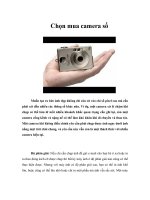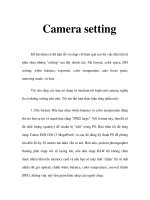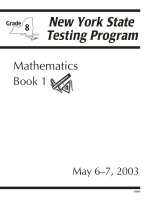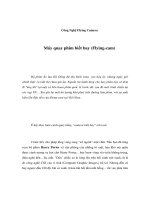E10 program AE camera technique
Bạn đang xem bản rút gọn của tài liệu. Xem và tải ngay bản đầy đủ của tài liệu tại đây (977.22 KB, 8 trang )
Camera Basics
Program AE (P mode)
The Program AE mode, a semi-automatic mode where the camera automatically
sets the aperture and shutter speed, enables you to shoot quickly to capture
sudden photographic opportunities, and yet still retain creative control over other
settings such as white balance.
Program AE: The point-and-shoot mode where the camera determines the aperture
and shutter speed
Points-to-note
- The camera decides on both the aperture and the shutter speed.
- It’s great for capturing sudden, unexpected shutter opportunities.
- Unlike fully-automated modes, you can still change other settings such as white
balance (W B) and exposure compensation.
It can be tremendous fun to experiment with different shutter speed and aperture
settings, but finding the perfect combination often takes ti me and can result in lost
photo opportunities. Yet, those who also want to retain some creative control over
the photo outcome might feel restricted by fully -automated shooting modes. That's
when Program AE mode comes in handy. In this mode, the camera aut omatically
determines and sets the optimum aperture -shutter speed combination, making it
ideal if you need to shoot fast to capture unexpected shutter opportunities. If you
use it together with the ISO Auto setting, you can also take handheld snapshots
with minimal camera shake.
How, then, is it different from fully-automated modes such as Scene Intellige nt
Auto? For one, the latter is targeted at beginner users, so the camera
automatically sets almost all shoot settings, such as the AF function and metering
mode, in order to lessen the risk of failed shots. It therefore offers little room for
customization for those who want a bit more leeway with creative expression.
Program AE mode, on the other hand, takes over only the aperture and shutter
speed settings. It still allows you to customize the white balance, Picture Style,
and exposure compensation settings, among others, to better reflect your shooting
intent.
One thing that makes Program AE mode different from Aperture -priority AE mode,
where you set the aperture value, and Shutter -priority AE mode, where you set the
shutter speed, is that the program might select an aperture value -shutter speed
combination that is different from your shooting intent. If that happens and you are
not happy with the results, you can keep the “correct” exposure and freely change
the aperture and shutter speed setting combinations. This is called a “ program
shift”.
The mode dial on your camera
To use Program AE mode, turn your camera’s mode dial until the arrow points at
[P].
The Quick Control screen
A: Shutter speed
B: Aperture
In [P] mode, the camera automatically sets both the aperture and the shutter
speed
The camera detects subject brightness, analyses it and then automatically sets a
shutter speed and aperture value that it deems “correct” for the scene. If this
exposure is not quite what you want, you can use exposure compensation to
change it.
Usage example #1: When capturing brightly -lit backgrounds
EOS 5D Mark III / EF24-105mm f/4L IS USM/ FL: 35mm/ Program AE (f/9, 1/200
sec, EV+0.3)/ ISO 100/ W B: Daylight
Let’s say you want to take snapshots of a distant landscape. As bokeh quality isn’t
a concern for such shots, Program AE mode would be a great choice of shooting
mode. Even if there are lots of clouds in the sky, you can rest assured that your
camera will set the optimum shutter speed and aperture settings for ideal
exposure, but still apply exposure compensation and adjust white balance if
required.
Usage example #2: For grabbing that unexpected shutter opportunity
EOS 6D/ EF24-105mm f/4L IS USM/ FL: 105mm/ Program AE (f/4, 1/100 sec,
EV+0.3)/ ISO 125/ WB: Daylight
With Program AE mode, all you need to do is press the shutter button to achieve
pretty decent photos. It therefore lets you capture precise pictures of fleeting
moments, such as a blink-and-you-miss-it expression on the face of a moving
subject.
Usage example #3: When you want to avoid handheld camera shake
EOS 5D Mark III/ EF24-70mm f/2.8L II USM/ FL: 50mm/ Program AE (f/4.5, 1/100
sec, EV-0.7)/ ISO 100/ W B: Daylight
In Program AE mode, the camera automatically chooses a shutter speed that best
reduces the chances of camera shake. Combining this with ISO Auto mode cuts
the risk of camera shake even further









